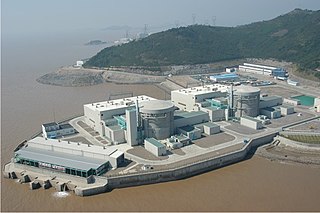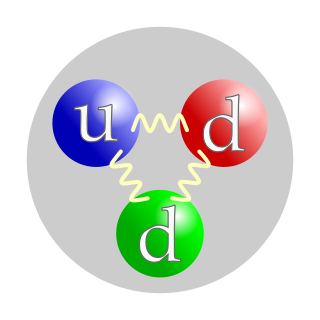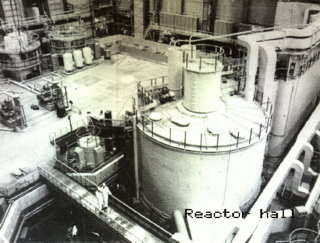
The CANDU is a Canadian pressurized heavy-water reactor design used to generate electric power. The acronym refers to its deuterium oxide moderator and its use of uranium fuel. CANDU reactors were first developed in the late 1950s and 1960s by a partnership between Atomic Energy of Canada Limited (AECL), the Hydro-Electric Power Commission of Ontario, Canadian General Electric, and other companies.

A nuclear reactor is a device used to initiate and control a fission nuclear chain reaction. Nuclear reactors are used at nuclear power plants for electricity generation and in nuclear marine propulsion. When a fissile nucleus like uranium-235 or plutonium-239 absorbs a neutron, it splits into lighter nuclei, releasing energy, gamma radiation, and free neutrons, which can induce further fission in a self-sustaining chain reaction. The process is carefully controlled using control rods and neutron moderators to regulate the number of neutrons that continue the reaction, ensuring the reactor operates safely. The efficiency of energy conversion in nuclear reactors is significantly higher compared to conventional fossil fuel plants; a kilo of uranium-235 can release millions of times more energy than a kilo of coal.

A pressurized water reactor (PWR) is a type of light-water nuclear reactor. PWRs constitute the large majority of the world's nuclear power plants. In a PWR, the primary coolant (water) is pumped under high pressure to the reactor core where it is heated by the energy released by the fission of atoms. The heated, high pressure water then flows to a steam generator, where it transfers its thermal energy to lower pressure water of a secondary system where steam is generated. The steam then drives turbines, which spin an electric generator. In contrast to a boiling water reactor (BWR), pressure in the primary coolant loop prevents the water from boiling within the reactor. All light-water reactors use ordinary water as both coolant and neutron moderator. Most use anywhere from two to four vertically mounted steam generators; VVER reactors use horizontal steam generators.

The pebble-bed reactor (PBR) is a design for a graphite-moderated, gas-cooled nuclear reactor. It is a type of very-high-temperature reactor (VHTR), one of the six classes of nuclear reactors in the Generation IV initiative.

In nuclear engineering, a neutron moderator is a medium that reduces the speed of fast neutrons, ideally without capturing any, leaving them as thermal neutrons with only minimal (thermal) kinetic energy. These thermal neutrons are immensely more susceptible than fast neutrons to propagate a nuclear chain reaction of uranium-235 or other fissile isotope by colliding with their atomic nucleus.

The Atomic Energy Research Establishment (AERE) was the main centre for atomic energy research and development in the United Kingdom from 1946 to the 1990s. It was created, owned and funded by the British Government.
NRX was a heavy-water-moderated, light-water-cooled, nuclear research reactor at the Canadian Chalk River Laboratories, which came into operation in 1947 at a design power rating of 10 MW (thermal), increasing to 42 MW by 1954. At the time of its construction, it was Canada's most expensive science facility and the world's most powerful nuclear research reactor. NRX was remarkable both in terms of its heat output and the number of free neutrons it generated. When a nuclear reactor such as NRX is operating, its nuclear chain reaction generates many free neutrons. In the late 1940s, NRX was the most intense neutron source in the world.

Magnox is a type of nuclear power / production reactor that was designed to run on natural uranium with graphite as the moderator and carbon dioxide gas as the heat exchange coolant. It belongs to the wider class of gas-cooled reactors. The name comes from the magnesium-aluminium alloy, used to clad the fuel rods inside the reactor. Like most other "Generation I nuclear reactors", the Magnox was designed with the dual purpose of producing electrical power and plutonium-239 for the nascent nuclear weapons programme in Britain. The name refers specifically to the United Kingdom design but is sometimes used generically to refer to any similar reactor.

The United Kingdom Atomic Energy Authority is a UK government research organisation responsible for the development of fusion energy. It is an executive non-departmental public body of the Department for Energy Security and Net Zero (DESNZ).

A fast-neutron reactor (FNR) or fast-spectrum reactor or simply a fast reactor is a category of nuclear reactor in which the fission chain reaction is sustained by fast neutrons, as opposed to slow thermal neutrons used in thermal-neutron reactors. Such a fast reactor needs no neutron moderator, but requires fuel that is relatively rich in fissile material when compared to that required for a thermal-neutron reactor. Around 20 land based fast reactors have been built, accumulating over 400 reactor years of operation globally. The largest was the Superphénix sodium cooled fast reactor in France that was designed to deliver 1,242 MWe. Fast reactors have been studied since the 1950s, as they provide certain advantages over the existing fleet of water-cooled and water-moderated reactors. These are:

The light-water reactor (LWR) is a type of thermal-neutron reactor that uses normal water, as opposed to heavy water, as both its coolant and neutron moderator; furthermore a solid form of fissile elements is used as fuel. Thermal-neutron reactors are the most common type of nuclear reactor, and light-water reactors are the most common type of thermal-neutron reactor.
PLUTO was a materials testing nuclear reactor housed at the Atomic Energy Research Establishment, a former Royal Air Force airfield at Harwell, Oxfordshire in the United Kingdom.

The gas-cooled fast reactor (GFR) system is a nuclear reactor design which is currently in development. Classed as a Generation IV reactor, it features a fast-neutron spectrum and closed fuel cycle for efficient conversion of fertile uranium and management of actinides. The reference reactor design is a helium-cooled system operating with an outlet temperature of 850 °C (1,560 °F) using a direct Brayton closed-cycle gas turbine for high thermal efficiency. Several fuel forms are being considered for their potential to operate at very high temperatures and to ensure an excellent retention of fission products: composite ceramic fuel, advanced fuel particles, or ceramic clad elements of actinide compounds. Core configurations are being considered based on pin- or plate-based fuel assemblies or prismatic blocks, which allows for better coolant circulation than traditional fuel assemblies.
The Steam Generating Heavy Water Reactor (SGHWR) was a United Kingdom design for commercial nuclear reactors. It uses heavy water as the neutron moderator and normal "light" water as the coolant. The coolant boils in the reactor, like a boiling water reactor, and drives the power-extraction steam turbines.
The Whiteshell Reactor No. 1, or WR-1, was a Canadian research reactor located at AECL's Whiteshell Laboratories (WNRL) in Manitoba. Originally known as Organic-Cooled Deuterium-Reactor Experiment (OCDRE), it was built to test the concept of a CANDU-type reactor that replaced the heavy water coolant with an oil substance. This had a number of potential advantages in terms of cost and efficiency.

A graphite-moderated reactor is a nuclear reactor that uses carbon as a neutron moderator, which allows natural uranium to be used as nuclear fuel.

Dragon was an experimental high temperature gas-cooled reactor at Winfrith in Dorset, England, operated by the United Kingdom Atomic Energy Authority (UKAEA). Its purpose was to test fuel and materials for the European High Temperature Reactor programme, which was exploring the use of tristructural-isotropic (TRISO) fuel and gas cooling for future high-efficiency reactor designs. The project was built and managed as an Organisation for Economic Co-operation and Development/Nuclear Energy Agency international project. In total, 13 countries were involved in its design and operation during the project lifetime.

Carolinas–Virginia Tube Reactor (CVTR), also known as Parr Nuclear Station, was an experimental pressurized tube heavy water nuclear power reactor at Parr, South Carolina in Fairfield County. It was built and operated by the Carolinas Virginia Nuclear Power Associates. CVTR was a small test reactor, capable of generating 17 megawatts of electricity. It was officially commissioned in December 1963 and left service in January 1967.
A gas-cooled reactor (GCR) is a nuclear reactor that uses graphite as a neutron moderator and a gas as coolant. Although there are many other types of reactor cooled by gas, the terms GCR and to a lesser extent gas cooled reactor are particularly used to refer to this type of reactor.

An organic nuclear reactor, or organic cooled reactor (OCR), is a type of nuclear reactor that uses some form of organic fluid, typically a hydrocarbon substance like polychlorinated biphenyl (PCB), for cooling and sometimes as a neutron moderator as well.

















